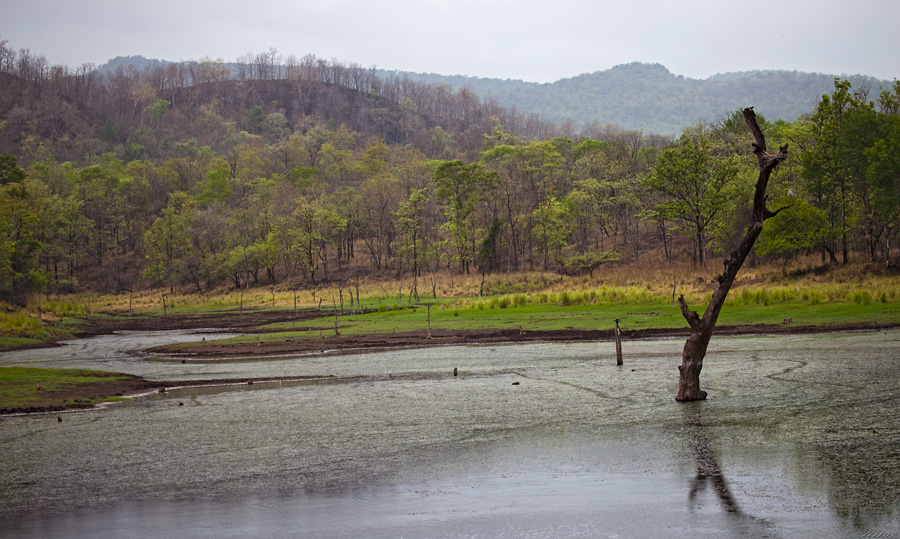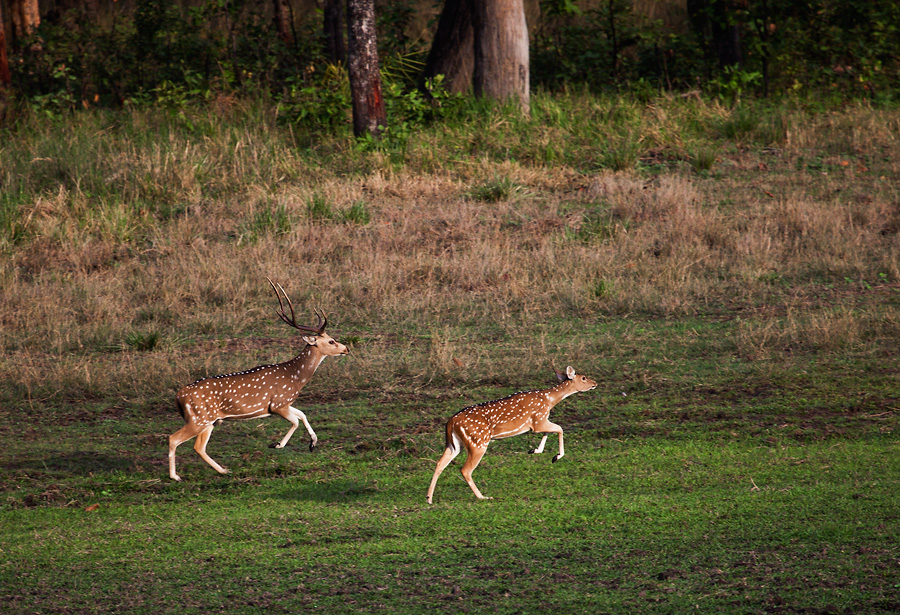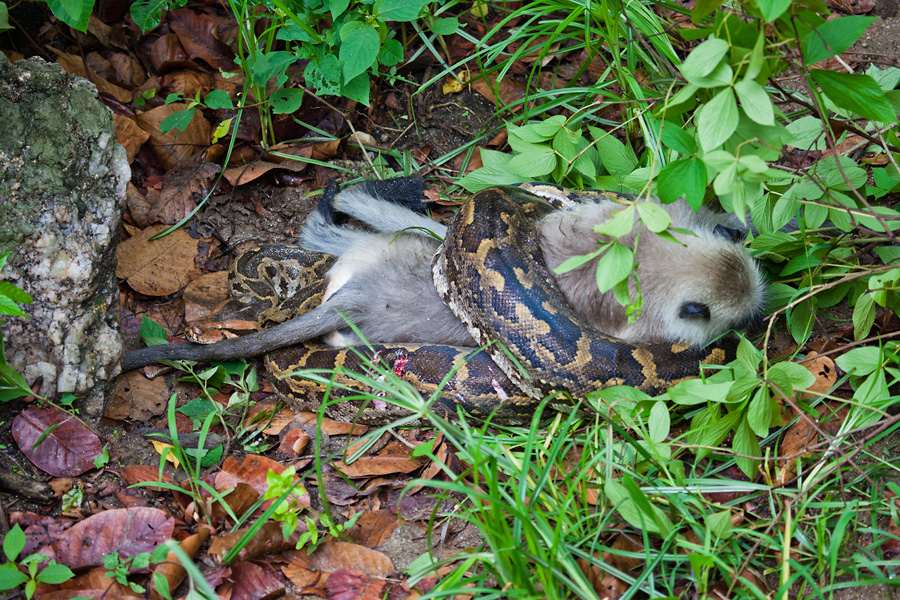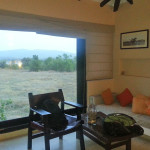Witnessing the mysteries of Madhya Pradesh’s jungles
In the second half of June, I travelled with Pugdundee Safaries through the wilderness of Madhya Pradesh, seeing life in the jungles and witnessing some fairy-tale-like events unfold in front of my eyes.
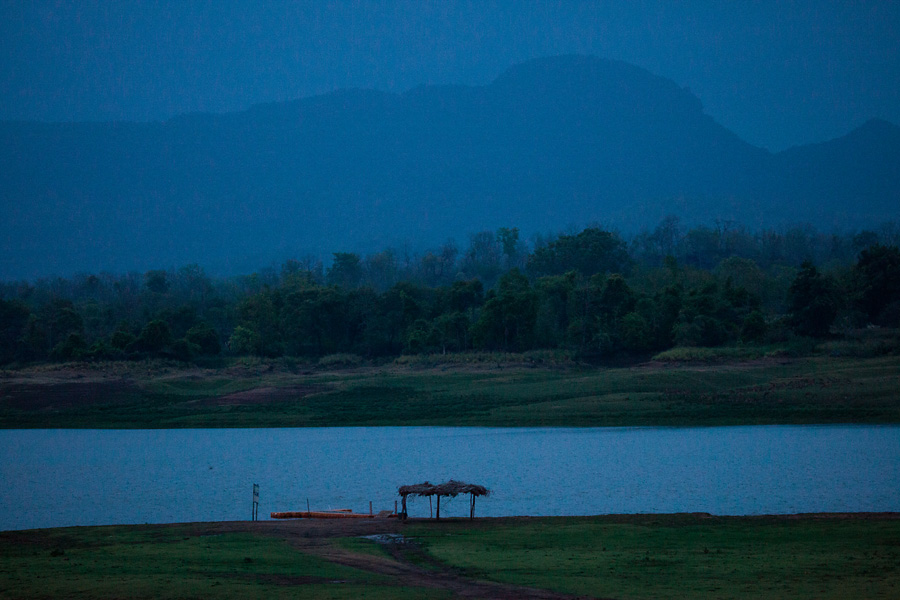 It was dark when I arrived in Satpura. I couldn’t see much, but the absence of cellphone networks gave me hint of what I should expect. The next morning, we headed out when it was still dark, depriving me of the details of the place where I was staying. There were words spoken previous night–about a jamun tree, the river waters that surrounded us and the animals that roamed the region. They would have to wait for the afternoon until I came back from our sortie into the protected areas of Satpura National Park.
It was dark when I arrived in Satpura. I couldn’t see much, but the absence of cellphone networks gave me hint of what I should expect. The next morning, we headed out when it was still dark, depriving me of the details of the place where I was staying. There were words spoken previous night–about a jamun tree, the river waters that surrounded us and the animals that roamed the region. They would have to wait for the afternoon until I came back from our sortie into the protected areas of Satpura National Park.
The onset of monsoons and the eruption of life
Light seeped in from the sky as we waited at the office of the forest-department for our permits. A long ribbon of glint on earth revealed the backwaters of Tawa River that flowed between us and the park. Beyond, the land rose quickly to form the hills of Satpura Ranges, now covered in tender greenery that had erupted after the first rains of the season. The skies were decorated with patches of clouds and the ground was moist with the night’s precipitation. Monsoon had imprinted its signature, assertively declaring the end of summer and rekindling the fecundity of the forest.
A change in season was even more evident as our jeep tread through the park. Fresh grass covered every inch of earth that was probably brown only a week ago. Young green leaves adorned the trees as though they were just rejuvenated with an elixir of youth. Cicadas went about celebrating in every tree through a symphony that they couldn’t stop playing. Spotted deer, the very alert and flighty creatures of the forest stayed close to human habitation, enjoying the abundance of fresh grass. Birds flew about in search of a good breakfast, probably a juicy grub of crawlers that have fed themselves fat on new leaves. The woods were now fully awake!
A swarm of termites and opportunist birds
The new found activity with the coming of monsoons was nowhere as frenzied as it was in the ant-hills. Termites erupted from the ground in large numbers, taking wings in the hope of finding a mate and creating new colonies.
First few days of the rainy season is a time for termites to expand their colonies. With the scent of first rain, reproducing adults with grown wings come out of the colony to fly away, mate and build a new empire. They swarm out in large numbers, shed their wings soon after mating and land somewhere away to raise their new generation.
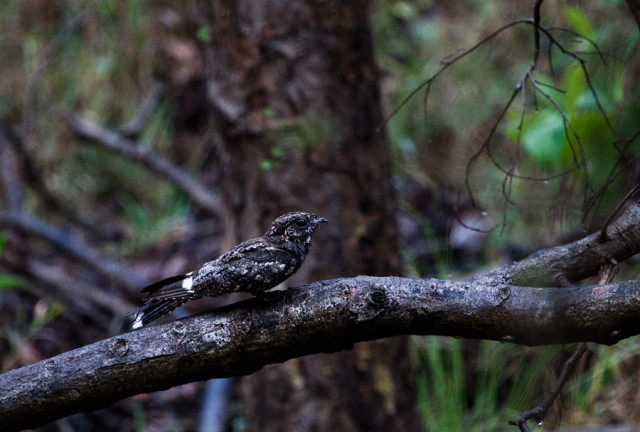 However, not every termite that comes out of its earthen comforts makes it to a new ground. When nature gets alarmed at the possibility of a plague of termites guttling a forest, it sends birds to put things under control. When we first saw this army of swarming termites, some of the winged destroyers had already arrived to feed on them for breakfast. An orange-headed thrush gulped on greedily, eating hurriedly in a wish to consume as much as it can while the buffet lasted. A bunch of drongos took a more dignified approach, watching the commotion from a distance and occasionally intercepting a termite in the air.
However, not every termite that comes out of its earthen comforts makes it to a new ground. When nature gets alarmed at the possibility of a plague of termites guttling a forest, it sends birds to put things under control. When we first saw this army of swarming termites, some of the winged destroyers had already arrived to feed on them for breakfast. An orange-headed thrush gulped on greedily, eating hurriedly in a wish to consume as much as it can while the buffet lasted. A bunch of drongos took a more dignified approach, watching the commotion from a distance and occasionally intercepting a termite in the air.
The drongos did this effortlessly as they flew like fighter planes, making sudden turns and coming to a sharp mid-air halt to aim their beaks precisely at a flying insect. Driving further, we saw a pied kingfisher–a master when it comes to speed-diving and catching fish on the go–making a not-so-artistic attempt at doing the same. It was successful, nevertheless, thanks to the abundance of prey in the air. This kingfisher sat on the tip of a dry branch and kept a lookout for its victims. On finding a passing termite, it would fly out clumsily in a straight line, making no attempt to hide its inabilities to make drongo-like acrobatics but nevertheless lapping up some food in the beak on its way back to the perch. I let out an involuntary ‘oooh’ the first time I saw the successful hunt.
The kingfisher was an opportunist taking a break from fishing and resorting to some ‘insecting’. A little while later, we saw another opportunist – an Indian nightjar. As the name indicates, these birds are active in the night and hunt in darkness. But it so turned out that today’s feast in the forest was too good to resist and worth a sleepless day! This nightjar we found, instead of sitting pretty in its camouflage on the barks as they are supposed to, was busy devouring the termites and enjoying a late morning dinner before it went to sleep!
A threat from lapwings in Denwa Backwaters
Later in the day, back at Denwa Backwater Escape where we were staying, I could set my eyes on things that I couldn’t see previous evening in the darkness. The lodge was in a green setting flanked by the backwaters of Tawa Reservoir. My room, the balcony and the al-fresco dining area were all facing a wide section of the very inviting backwaters. The lake was surrounded by gently undulating slopes covered with a thin layer of grass that painted the earth green. It was reason enough for me abandon the afternoon safari in the park and go for a long walk at the edge of the water.
I spent a good part of the time after lunch lazing in the room and gazing at the reservoir. As the sunlight began loosing intensity towards the evening, I headed out towards the water, walked for sometime in the open until I reached a long peninsular projection that hosted a scattering of red-wattled lapwings.
These birds did not seem to like me.
Lapwings are ground-dwelling and nesting birds that breed and nest in late-summer and early-monsoon months. I was now walking in their territory at a time when they might have had a few eggs in a nest somewhere on the ground, ready to hatch. They probably saw a predator in me and did not want me anywhere nearby. One of the lapwings came flying towards me, hovered directly above and hollered from the depths of its throat. It did this persistently, moving away shortly and coming back again and again. While one of them tried to scare me away, another one walked noisily on the ground, walking not too far from me and trying to draw my attention.
Trying not to upset the parents-to-be, I walked carefully, searching for nests that I might accidentally step on and eventually settled down at a place where the birds did not seem to mind.
This time, I was very close to the water and was now threatened by a pair of river terns that were peacefully flying around until now. I gave in, shifted my place again until everyone was happy. This also turned out to be a great spot for me to watch the birds without interfering their lives–the lapwings, the terns and also a pair of very weary stone-curlews that always kept a watch on me.
For rest of the evening, I idled at this spot, watching the lapwings continuously scurry on the ground appearing busy, terns flying effortlessly above the water and the curlews standing still and staring at me with one eye.
Dance of the peacocks
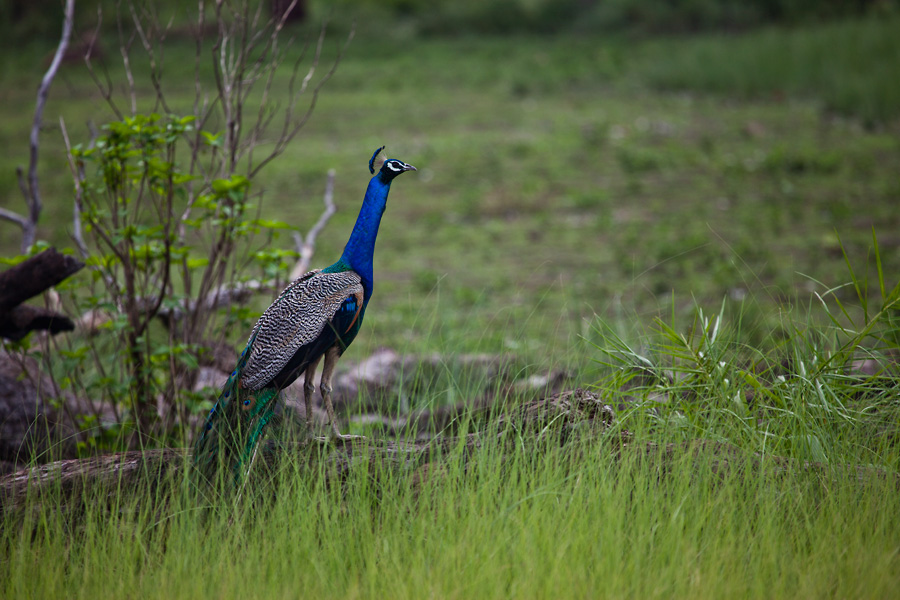 Our next stop was Bandhavgarh National Park, where we could see signs of the arriving monsoons, but not completely there yet. The air had the stillness of a hot summer, but was frequently refreshed by a breeze that brought the message from approaching clouds. The animals of the forest, just like us, were asking for rain. While most forest dwellers silently waited, peacocks were very candid about their craving.
Our next stop was Bandhavgarh National Park, where we could see signs of the arriving monsoons, but not completely there yet. The air had the stillness of a hot summer, but was frequently refreshed by a breeze that brought the message from approaching clouds. The animals of the forest, just like us, were asking for rain. While most forest dwellers silently waited, peacocks were very candid about their craving.
On our very first venture into the park, we spotted a bunch of them impatient with desire–for the rains and for a mate–dancing away rapidly moving their feet and spreading their dazzling tail wide open. Good for us, the waiting females were unimpressed and the dance went on for some time! In the next two days, we would see many more peacocks that added colour to the park, but they were all much sober and none of them danced with the exuberance we witnessed the first time.
An assembly in the forest – chitals, wild boar, jackals and a sambar deer
A half-an-hour’s drive from the peacocks, we were at a shallow lake bed that had completely gone dry. The open space had turned into a small playground for the local wilderness club members. There was a good population of chitals (spotted deer) in one corner chewing on the tender grass. The group consisted several young ones that were running helter-skelter like the young ones always do. Their parents, of course, ran behind them like the parents always do!
In another corner of the lake bed, a wild boar diligently chewed on a mass of something that we could no identify from the distance we were at. A jackal–not a common sight in most parts of India anymore–settled down and relaxed, not very far from the boar. A sambar deer kept a dignified presence, minding its own business, not bothering others and not bothered by anyone around.
After a while, the boar got bored of whatever it was chewing and decided to make an exit. Suddenly, the jackal, which was probably waiting for its turn all along, sprung up and continued from where the boar had left. While the jackal chewed on, a king vulture, next in line, waited for its chance! While all this happened, the young chitals full of energy continued to play and annoy their parents.
The butterfly effect
Of all the wonders that I witnessed in the forest, if there is one experience that I had to pick as the most memorable, it is seeing a tree getting attacked by butterflies! During one of the safari drives, we arrived at a road junction with a lone tree standing in the center. A couple of vehicles had gathered at the junction and I couldn’t make out why. On getting closer I realized I was witnessing a phenomenon I had never seen before.
This particular tree, whose name I wish I knew, had begun flowering and was now bearing thousands of tiny flowers. The flowers had attracted an army of butterflies that had swarmed the tree in thousands! They were hopping from branch to branch, enjoying the sweet nectar and distributing some of their joy to us in the process! There were about five varieties of butterflies that included striped tigers, lemon emigrants and common mormons. They were everywhere on the tree, flying from flower to flower and briefly stopping to suck fresh nectar. It looked as though the tiny leaves in the tree suddenly took wings and made the most graceful form of flight ever possible!
The bear and the termites
This one–a bear digging and slurping termites–I did not get to see. But I was described about it by my fellow travellers with great enthusiasm. And later, I got a chance to see the visuals of what they narrated…
The python and the langur
This is the kind of stuff that exciting tales from the forest are made of! Our journey through Central India led us south of Bandhavgarh to Kanha National Park, which seemed to be packed with all the excitement and action from the animal world. On one of the sojourns into the forest, we spotted a fat python happily wrapped around a common langur, now already past its last breath after what might have been a big struggle for life. The langur’s body appeared unscathed although the python’s tight hug must have broken every bone inside. But the struggle had left a few gashes on the python’s skin, which were likely to heal in some time.
When we passed by, the hunt was probably just complete and the serpent was trying to recover before consuming the pray. It’s likely that the python fell on the langur, enveloped it well before the langur understood what is happening and they both fell off the tree before the strangulation was complete. The python’s muscular body was still wrapped around langur’s abdomen when we reached there. The killer was in no hurry to consume, and the park timings forced us to leave the place soon.
The tiger and a porcupine
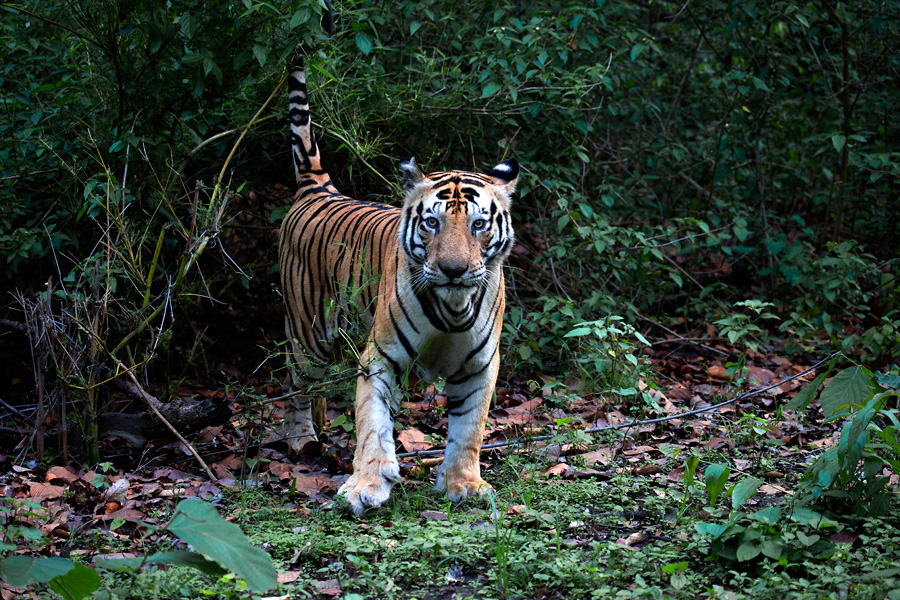 All these incredible stories set aside, Madhya Pradesh’s jungles are more famous for tigers among its visitors than any other form of wildlife. On one of the days of driving through Kanha, our vehicle cruised for a few minutes next to Munna, apparently one of the largest tigers in the region and often called the ‘rock-star’ by local naturalists. Much has been documented about these animals by our tiger-crazed population. The internet and the wildlife photography forums should be full of images of every move of every tiger–tiger looking left, looking right, looking straight, left leg forward, right leg forward, standing, sitting, yawning, hunting and panting–that I have little more to add here.
All these incredible stories set aside, Madhya Pradesh’s jungles are more famous for tigers among its visitors than any other form of wildlife. On one of the days of driving through Kanha, our vehicle cruised for a few minutes next to Munna, apparently one of the largest tigers in the region and often called the ‘rock-star’ by local naturalists. Much has been documented about these animals by our tiger-crazed population. The internet and the wildlife photography forums should be full of images of every move of every tiger–tiger looking left, looking right, looking straight, left leg forward, right leg forward, standing, sitting, yawning, hunting and panting–that I have little more to add here.
The next morning Munna was still hanging out among the same bushes, now enjoying a breakfast of porcupine meat that he seemed to be very happy to have.
Over a week’s journey through the jungles, I witnessed incredible stories that came in all forms and sizes. It all started with tiny ants and grew larger with the progress of time, ending with a tiger. I will leave you to wonder which one fascinates you most and which story would you love to see unfolding in front of your eyes.
Epilogue – Madhya Pradesh with Pugdundee Safaris
I traversed the jungles of Madhya Pradesh on invitation from Pugdundee Safaris, which facilitates travellers in its wildlife lodges across the state. While our days were spent roaming the jungles, evenings were dedicated for absolute comforts in the lodge premises. Do find out more about them at Denwa Backwater Escape in Satpura, Kings Lodge Bandhavgarh and Kanha Earth Lodge.
